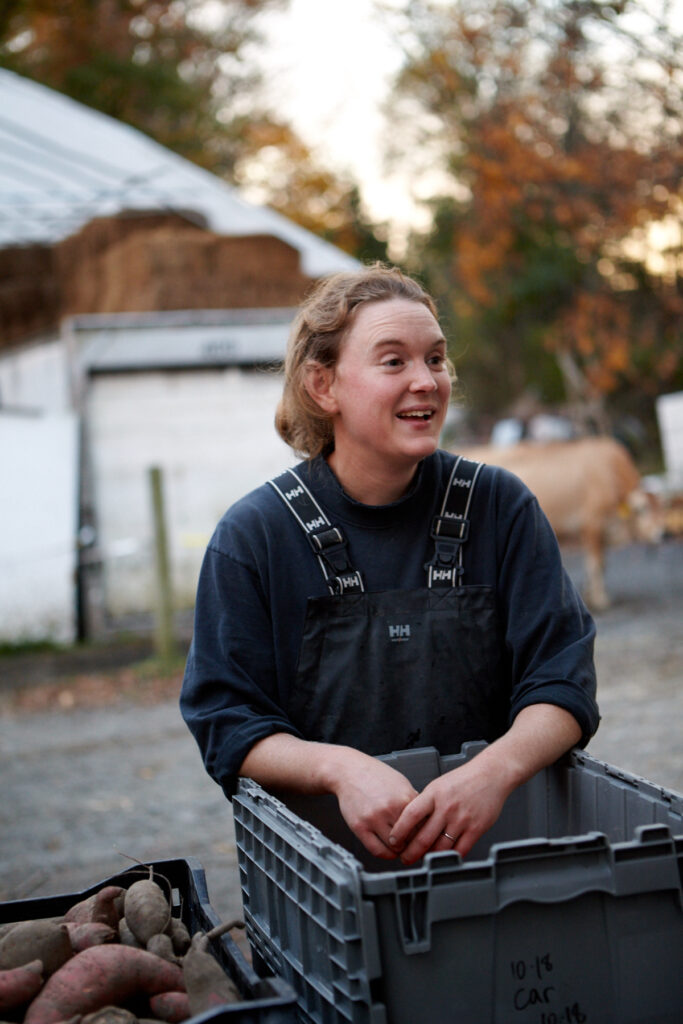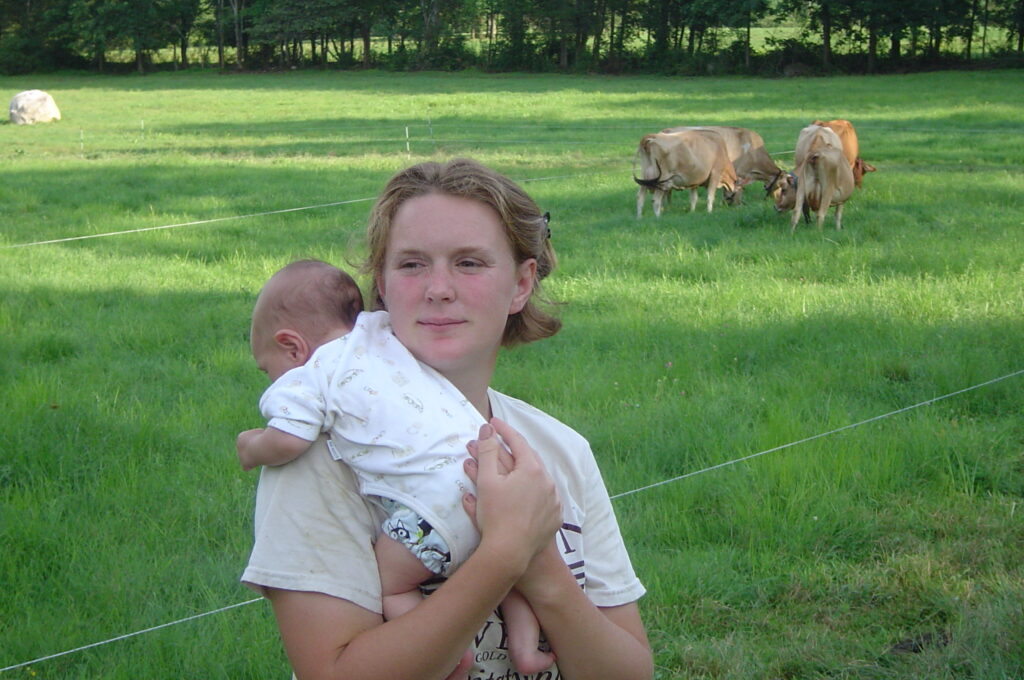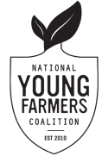Husband and wife team Becky and Joe Fullam have been farming together since 2009. They currently co-own and manage Old Ford Farm, located on several parcels of land in Gardiner, NY, 80 miles north of New York City. They operate a raw milk dairy and raise poultry, eggs, beef, and pork, and grow diversified vegetables with the help of two full-time employees and one seasonal worker. The farm’s mission is to produce quality foods, build community, and to use farming methods that promote the long-term health of the land, animals, and environment.
Becky became interested in sustainable agriculture while she was in college and volunteering in an urban community garden. She spent a summer interning on a diversified farm near Troy, New York, and fell in love with the work. At the time Joe was studying mechanical engineering but was looking for a career path that could use his interests in innovation in a more fulfilling way than a traditional engineering job. After visiting Becky at the farm where she was interning, it seemed that starting a farm was the way to do this.

Neither Becky nor Joe came from a farming background and they didn’t have significant savings, but found their first piece of land to rent in Gardiner, New York through what Becky describes as a “fluke.” On the suggestion of a friend, they reached out to the Wallkill Valley Land Trust. One of the members of the board at the time was a landowner and environmentalist who was interested in keeping the land in farming and had donated a conservation easement on the parcel. The landowner drew up a lease with Becky and Joe and let them farm the land for free, in exchange for the reduction in property taxes that they were able to receive through New York’s agricultural assessment program.
Though the zero-dollar lease was a boon for them as beginning farmers, there was no existing infrastructure on the property—no running water, electricity, driveways, or a residence. Becky and Joe implemented makeshift systems in order to get the farm off the ground on the rented land. But without a long-term lease, they did not have the security to build permanent infrastructure. In addition, the size and quality of the land was inadequate for the operation they were trying to build.
In 2014, Becky and Joe began searching in earnest for a more permanent piece of farmland for Old Ford Farm. When they began their land search, they were “pleasantly surprised to find a lot of organizations and people who were working on this issue.” They worked with Glynwood, a farm incubator in the Hudson Valley, and were connected with Dirt Capital Partners, a socially-responsible farmland investment company. From there, they were put in contact with American Farmland Trust, Scenic Hudson, and the National Young Farmers Coalition. “No one had an answer or silver bullet, but people were around and able to talk about it,” Becky said.
Like many young farmers beginning the search for quality, affordable farmland, Becky and Joe encountered many challenges, from lack of properties on the market to poor soil quality, and exorbitant prices.
“The cost of many properties was completely out of reach for what a farming income can afford.”
Most farmland on the market had poor drainage and other soil quality issues. Much of the land that had been in orchards in the 1950s was contaminated with lead and arsenic, which were used as pesticides. They found that the highest quality farmland was either already in agricultural production or not for sale. Besides problems with the soil, many properties also came with large, old houses requiring expensive repairs that they couldn’t afford. A further restriction on their land search was that they needed to be on or close to a main road, as they operate a self-serve farm store on their property and around 90 percent of their income is from direct-to-consumer sales.
An additional complication to Becky and Joe’s search was the fact that the radius in which they were looking was restricted by a couple of factors. In order to cash flow a purchase, they would need to keep their current business operational while moving its physical location. This meant finding a new property close enough to their leased land that they could farm in both locations for a period of time. They also wanted to stay close to their existing farm in order to keep their customer base, since building up new markets—especially in areas with many other farms selling direct-to-consumer—can be challenging.
After some searching, they found a 90-acre “dream property” in Wallkill with good quality soil and access to markets. They worked with Dirt Capital to try to purchase it, but unfortunately there was a large house on the land which drove up its value. In addition, local zoning laws might have prevented the property, which was “of historical significance,” from being altered to build necessary farming infrastructure, but they wouldn’t be able to know until after they had purchased it—a risk Becky and Joe were not willing to take.
Despite that let down, and the major challenges they faced in finding suitable farmland, Becky and Joe eventually purchased a 38-acre property two miles down the road from their original rented land that included a house. They were able to finance the land purchase with assistance from Farm Credit East, savings from their time farming under the zero-dollar lease agreement, a loan from the landowner, and help from their family. The financing process was not without challenges, though. Becky and Joe had first tried to work with the Farm Service Agency, the federal lending arm of USDA designed to provide financing assistance to farmers, but delays and other challenges forced them to change course.
While owning this parcel gives Becky and Joe more security than a lease, it has its drawbacks. The property is wet—which makes raising livestock difficult and growing vegetables impossible—and the acreage is relatively small. Eventually, they would like to move to a larger property with better soil drainage, which would buffer them from weather extremes and the impacts of climate change, and provide an alternative to the hundreds of thousands of dollars of investments needed to improve drainage on their current property.
In searching for new land, they face all the same restrictions as the first time (the property must be nearby with good quality soil, housing, and proximity to a main road, at an affordable price) with the additional challenge of navigating a purchase while paying their mortgage, which would mean the deal would need to happen quickly to help them juggle the finances. Becky and Joe’s story may sound complicated, but unfortunately the obstacles they are encountering are incredibly common for young farmers. Instability in land access has cascading effects that ripple through the entire business, sapping energy, time, and resources.
“Sustainable agriculture is one solution to so many different problems. That’s why we’re doing what we’re doing. But I know that there are a lot more people who want to farm but aren’t able to,” said Becky when asked why land access needs to be addressed through public policy. As she sees it, there are two points of disconnect that continue to widen: the price discrepancy between sustainably grown food and conventional, as well as the disparity between the income a farm operation can generate and the cost of land.

“Your food should come from farms. That’s the best step people can take towards addressing this problem. When demand is there for local food, it will increase momentum for the whole movement.”
To begin to solve some of these challenges, “We need to bring the price of land down,” says Becky. One tool that can help keep farmland affordable for farmers is working farm conservation easements. While traditional agricultural conservation easements protect land from residential and other development pressures, they do not guarantee that an individual who earns their income from farming will own the protected land in the future. Working farm easements incorporate strong provisions, such as the option to purchase at agricultural value or preemptive purchase right, that not only protect land but also help ensure that protected land is sold at its agricultural use value to future farmer owners.
As pressure from non-farming residential owners and second-home buyers mounts in the Hudson Valley and other urban-influenced regions around the country, helping farmers compete is increasingly important. The price is worth paying: working farm easements keep productive agricultural lands in the hands of farmers who will continue to produce food for the region and energize local economies. In 2018, New York followed Vermont and Massachusetts in establishing that state farmland protection funding program dollars could be used for the added cost of working farm easements.
“I think it is an efficient use of tax dollars to preserve farmland. There are programs there, but there need to be more of them. There are limitations to conservation easements being awarded, and that’s too bad.”
Providing public funding for working farm easements is a critical step towards ensuring there is a base of affordable farmland for future farmers. In addition, easement programs must be modified and combined with other forms of assistance to help farmers access that land. At the time that Becky and Joe were looking for land, they had explored using a conservation easement to help reduce the cost, but funding programs are set up to work most effectively for current landowners, rather than prospective buyers. Purchasing the property first and applying for an easement down the road was too big of a risk for them, and besides, the program was not designed to work with smaller sized properties in the range that Becky and Joe were looking at.
Photos courtesy of Becky Fullam
